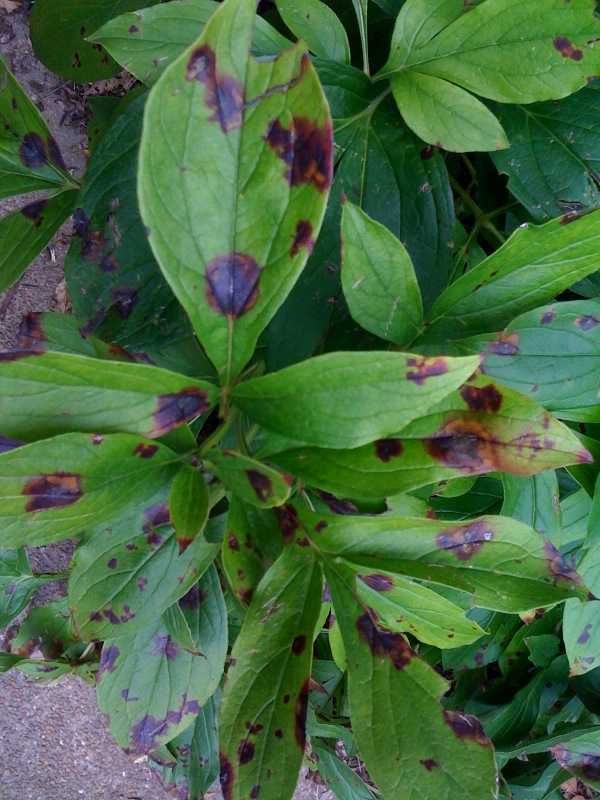 |
Botrytis blight (also called gray mold)
Botrytis blight is the most common disease of garden peonies and is prevalent in damp, rainy seasons. Young shoots rot at ground level when they are 5 to 8 inches tall. Stems often have a water-soaked appearance. Leafy shoots wilt suddenly and topple. The rotted portion of the plant becomes covered with a soft brown or blackish mass of fungal spores. Just above ground level, the stalk becomes covered with gray mold, which sheds large numbers of spores. Small buds that are affected turn black and wither. Larger buds turn brown and fail to open. Open flowers are occasionally affected and may turn brown and develop a covering of gray mold.
Lookalikes: Blights (such as, phytophthora blight, which lacks the classic fuzzy, gray mold), leaf spots, bud blast.
See “Botrytis Blight of Peony.” |
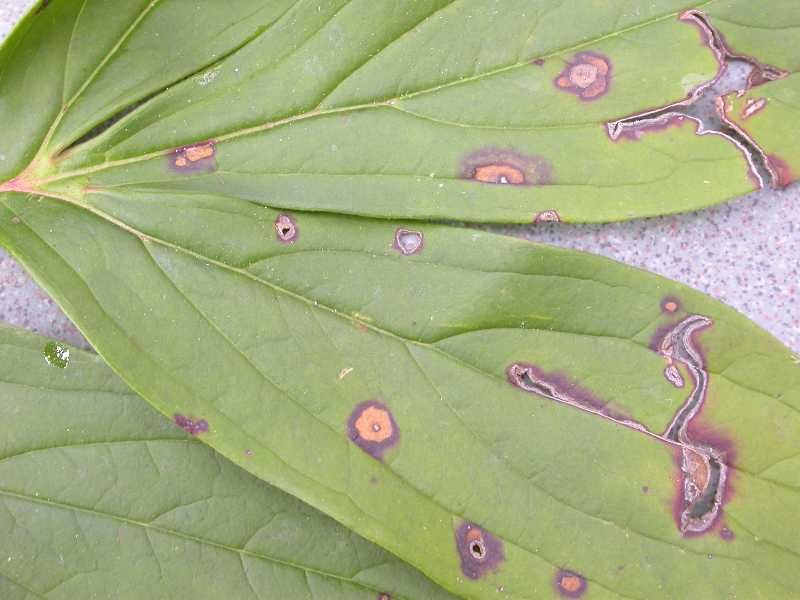 |
Peony blotch (also called red spot or measles)
This fungal disease occurs in spring just before blooming and affects all above ground parts. Small, circular red or purplish spots first appear superficially on the upper surface of young leaves. Later they coalesce intolarge, glossy, irregular dark purple blotches, while the underside of the spots becomes a dull chestnut brown. Short reddish-brown streaks appear on the young stems and petioles. Eventually the whole plant may have purplish or brownish red spots.
Although not immediately lethal, repeated bouts for several years will affect plant vitality. It does not cause early leaf drop or stem dieback but causes the plant to be unsightly and lose its attractiveness as spots coalesce to form blighted areas.
Lookalikes: Botrytis blight (has fuzzy, gray mold)
See “Peony Blotch.”
|
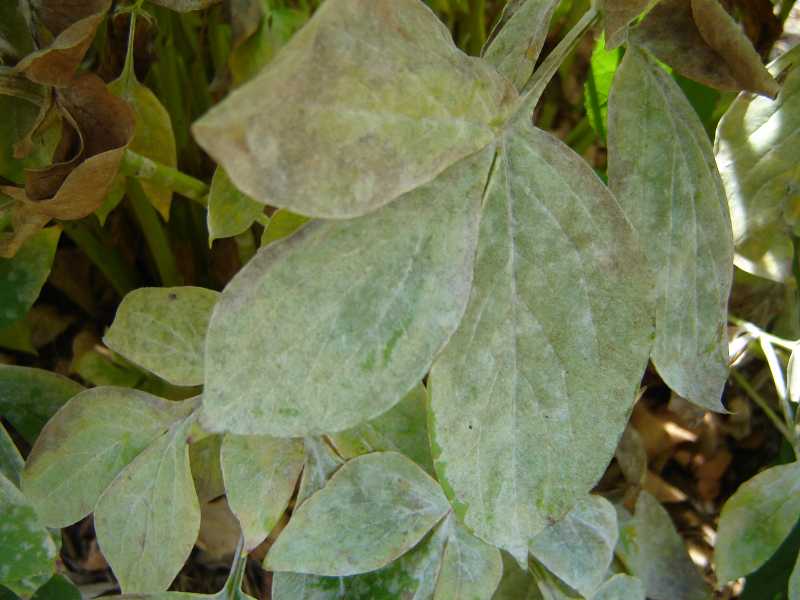 |
Powdery mildew
Powdery mildew is a fungal disease producing a light gray or whitish powder on the surface of leaves, young stems, and flowers. Flowers may be deformed. The disease is considered more unsightly than harmful. Death of the plant is rare.
See “Powdery mildew - Outdoors.” |
| |
Other fungal spots, blights and blotches
Peonies can be affected by a variety of fungal leaf spots. Most fungal leaf spots cause only cosmetic damage or occur late in the season, thus do not warrant control. Leaf spots are typically tan to brown with distinct borders or delimited borders on leaves or flower parts. When the spots become numerous and begin to merge the disease is called a blight or blotch or less commonly, scorch. In most cases, fungal leaf spot diseases are not significant enough to warrant fungicide applications.
Lookalikes: Anthracnose diseases (many are also leaf spots) and scorch (symptoms are browning of leaf margins and/or yellowing or darkening of the areas between the main leaf veins)
See “Fungal spots, blights, and blotches.” |
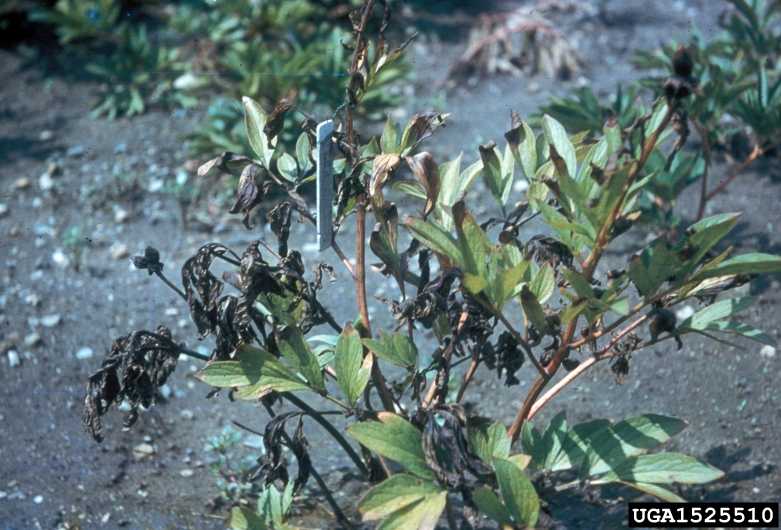
Department of Plant Pathology Archive, NCSU, Bugwood.org |
Phytophthora blight
A fungus, Phytophthora cactorum, which lives in moist soils, causes phytophthora blight. Flooded and saturated soil conditions are especially conducive to the spread of phytophthora blight. Wounds are not required for infection. The stems around the soil-line may appear darkened and leathery; they may wilt and die. The plant can develop root and crown rot causing the entire plant to rot. The entire plant can be pulled up easily.
Lookalikes: Botrytis blight (has fuzzy, gray mold) and other rots and wilts
See “Phytophthora Root Rot of Trees and Shrubs.” |
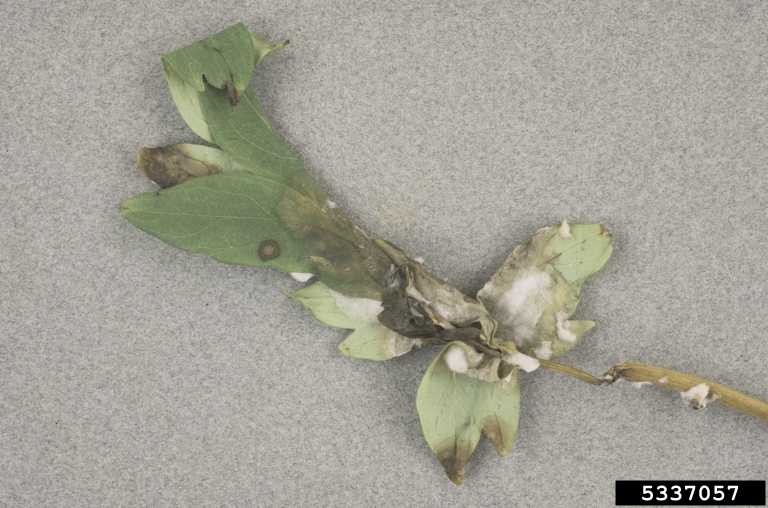
Sclerotinia rot of peony VA Tech Learning Resource Center, VPISU, Bugwood.org
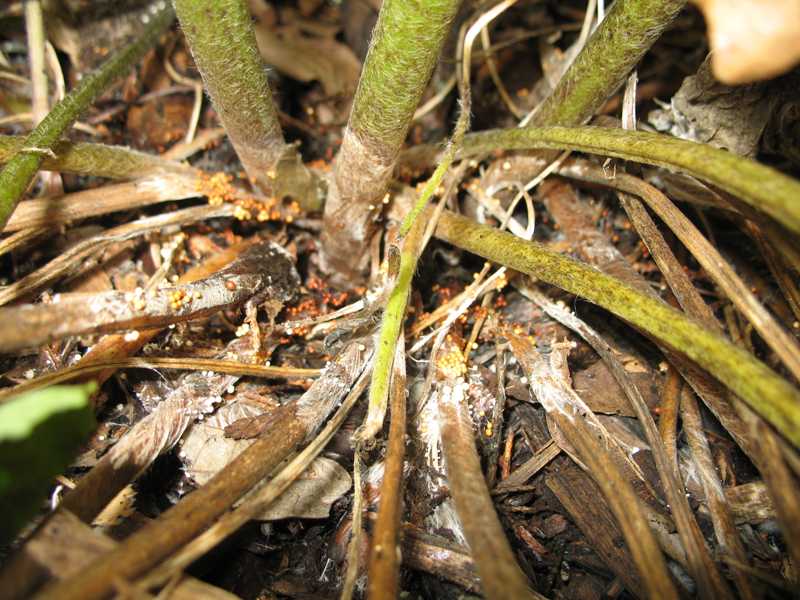
Sclerotia (resembling mustard seeds) and white cottony webbing on anemone |
Southern blight (also called, crown rot or white mold)
Southern blight, a fungal disease, causes deterioration and rotting of the tissues at the crown of the plant causing the leaves to turn yellow, collapse, and die. Beginning in early summer, infected plants develop discolored, water-soaked stem lesions near the soil line. During periods of high humidity, coarse cottony webbing (mycelia) develops and fans out over the stem base and surrounding soil. Sclerotia, which resemble mustard seeds and vary from white to reddish tan to light brown in color, develop at the base of the plant. Enough sclerotia may form to create a crust on the soil. It can kill the entire plant. The problem generally requires removal of the diseased plant.
Lookalikes: Wilts, root rots
See “Crown Rot of Perennials (Southern Blight).” |
|
Other fungal rots and wilts
Peonies like good drainage and overly wet soil can result in rots or wilts. Typically, initial wilting will occur in warm weather, followed by partial recovery in the evening. The wilt will intensify and leaves yellow, often taking on a scorched appearance. Lower leaves are affected first and often, only one side of the plant will appear to be affected. The disease results in stunted growth and premature death of the plant.
Lookalikes: Scorch and drought or water stress
See “Root, stem, crown, and collar rot.” |
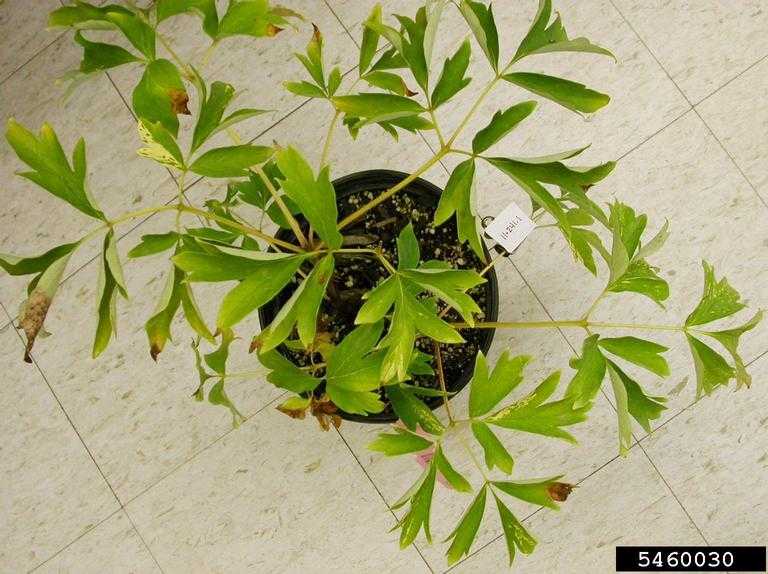
Hosta virus X on peony A. Phibbs, DATCP, Bugwood.org

Tobacco rattle virus on peony A. Phibbs, DATCP, Bugwood.org |
Viral Diseases
Peonies are subject to a variety of viruses including peony ringspot virus, leaf curl, Le Moine disease, crown elongation, and mosaic. Symptoms include a general dwarfing of the plant, lack of proper chlorophyll production resulting in a mottled appearance on foliage, yellowing and in some cases rings on leaves as well as necrotic (dead) areas. These diseases can be spread by feeding insects or mites, or mechanically through hands and tools. Infected plants cannot be cured. Remove and dispose of infected plants.
Lookalikes: Damage caused by 2,4-D, other disease organisms or even environmental problems
See “Viruses and phytoplasmas.” |
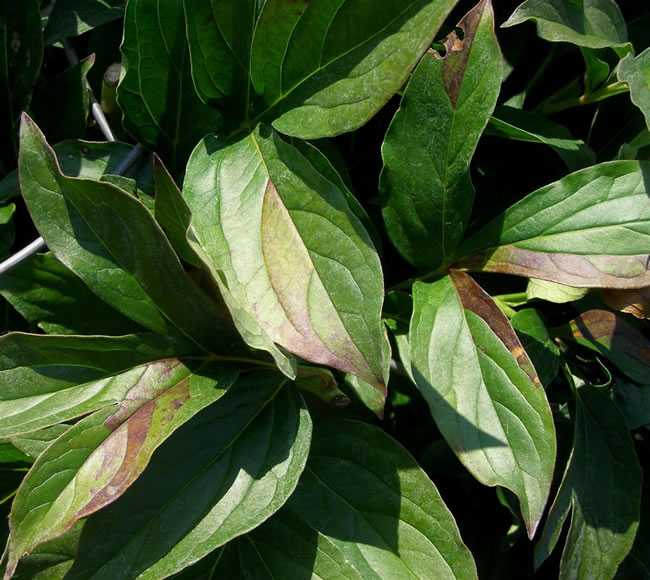
Michelle Grabowski, University of Minnesota Extension |
Foliar nematodes
Foliar nematodes, unlike root nematodes, attack plant parts above the ground. They spread quickly, displaying symptoms similar to other diseases. The most prominent symptoms occur in the leaves, beginning as angular, water-soaked lesions between the veins. These lesions will become brown and eventually turn black, often dropping out leaving a ragged, wind-tattered appearance. Other symptoms may appear as stunting, multicolored leaves, lack of flowering, leaf proliferation (bunching of leaves around the crown), or plant death. New leaves can emerge without symptoms while older leaves turn brown and collapse or fall. Standing water on the leaves promotes nematode spread as they can swim and infect new areas of the leaf or plant. Keeping foliage dry can help limit nematode spread.
Lookalikes: Leaf spots, failure to bloom, wilt
See “Foliar Nematodes.” |
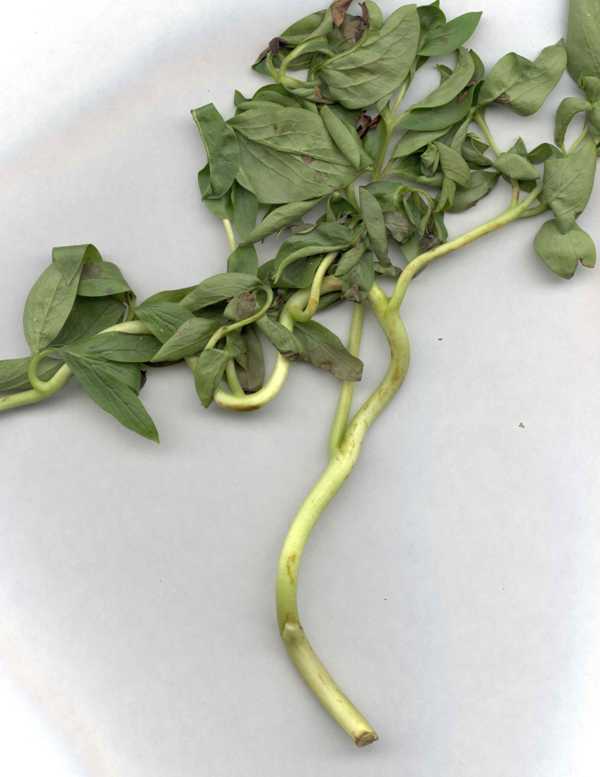
Twisted stem on peony and distorted growth caused by herbicide injury |
Herbicide damage
Herbicide damage can be hard to diagnose but twisting, deformed or distorted growth is a common symptom. Discolored or dead spots on leaves can result from some herbicides.
Lookalikes: Viral diseases, adverse weather, salt damage, drought, soil compaction, misapplied fertilizers, root stress, and nutrient deficiencies
See “Herbicide Damage to Plants.” |
|
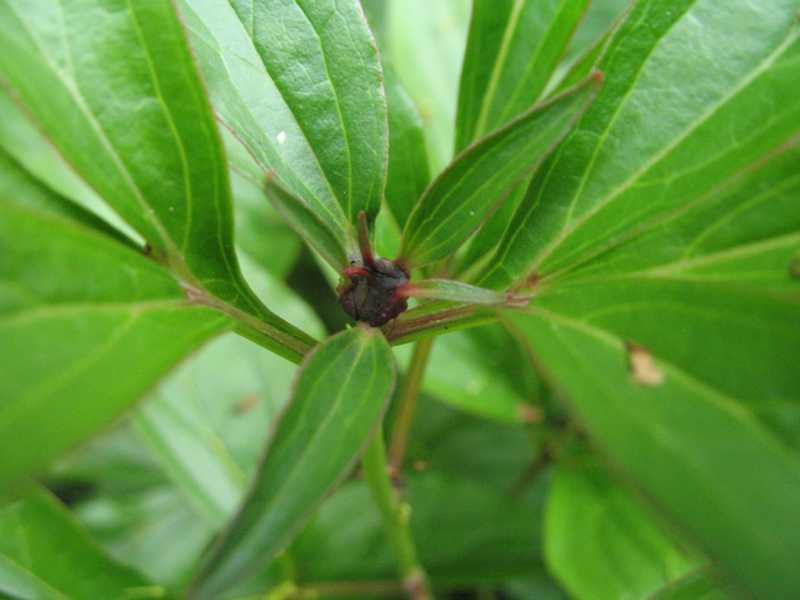
Peo-sized brown flower buds are characteristic of bud-blast on peony
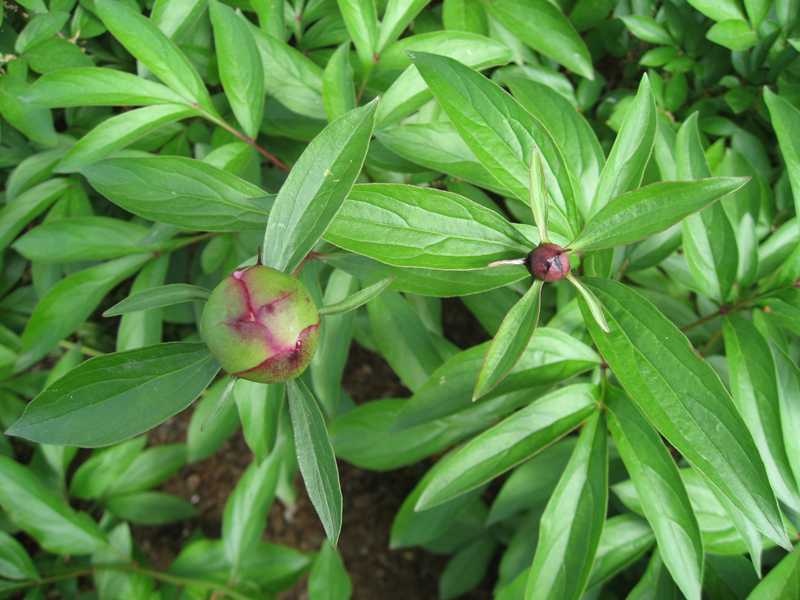
Normal bud on left; blasted bud on right
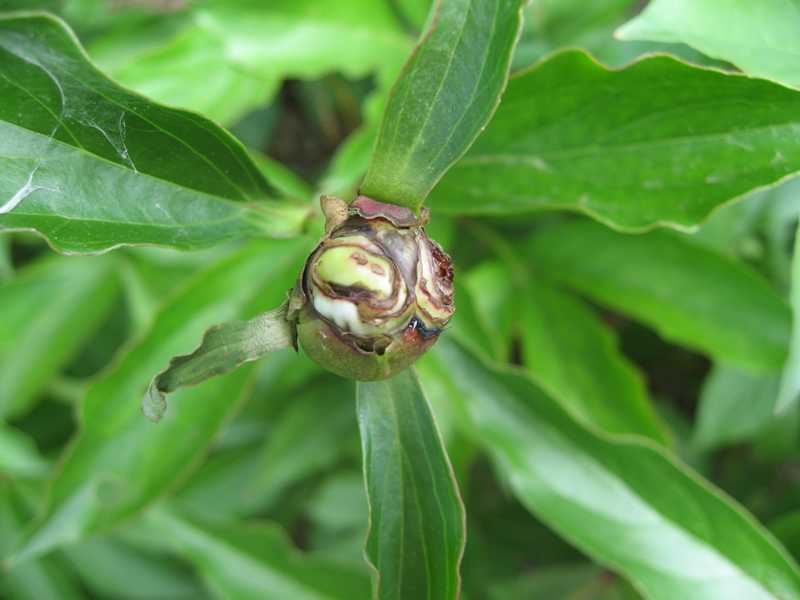
Frost injury
|
Bud-blast
Anything that stresses the plant could result in bud-blast, a condition where the peony flower buds fail to open. The causes for this condition include infertile soil, too-deep planting, immature plants, too much shade, drought, and cold weather injury frequently associated with late spring frosts.
Lookalikes: Botrytis blight (the flower buds become brown and papery, and gray mold characteristics are present)
See “Bud-blast of Peony.” |
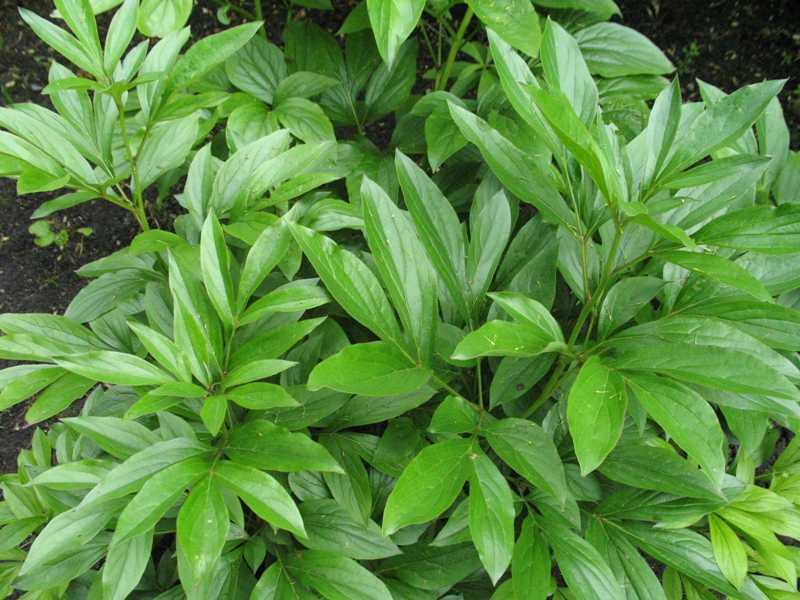 |
Failure to bloom / Poor flower production
The most common reasons for peonies failing to bloom are:
•Bud-blast (see above)
•Plants immature having fewer than three eyes
•Planted too deep
•Not enough sun
•Competition from surrounding trees and shrubs
•Excessive nitrogen fertilizer
•Plants undernourished, weak and small
•Foliage removed before next year's flowers are set (flower buds are set in fall in underground buds or eyes)
Lookalikes: Botrytis blight (has fuzzy, gray mold) and bud blast
See “Why did my peonies fail to bloom?” and “How do I grow peonies?” |
|
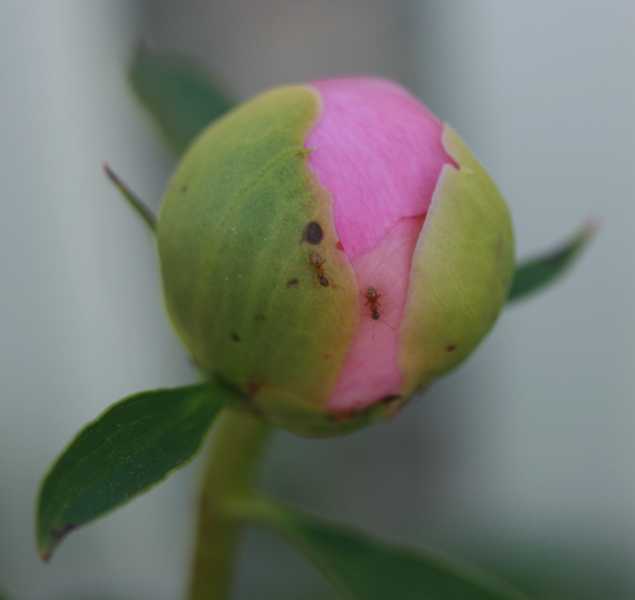
Ants looking for nectar on peony bud
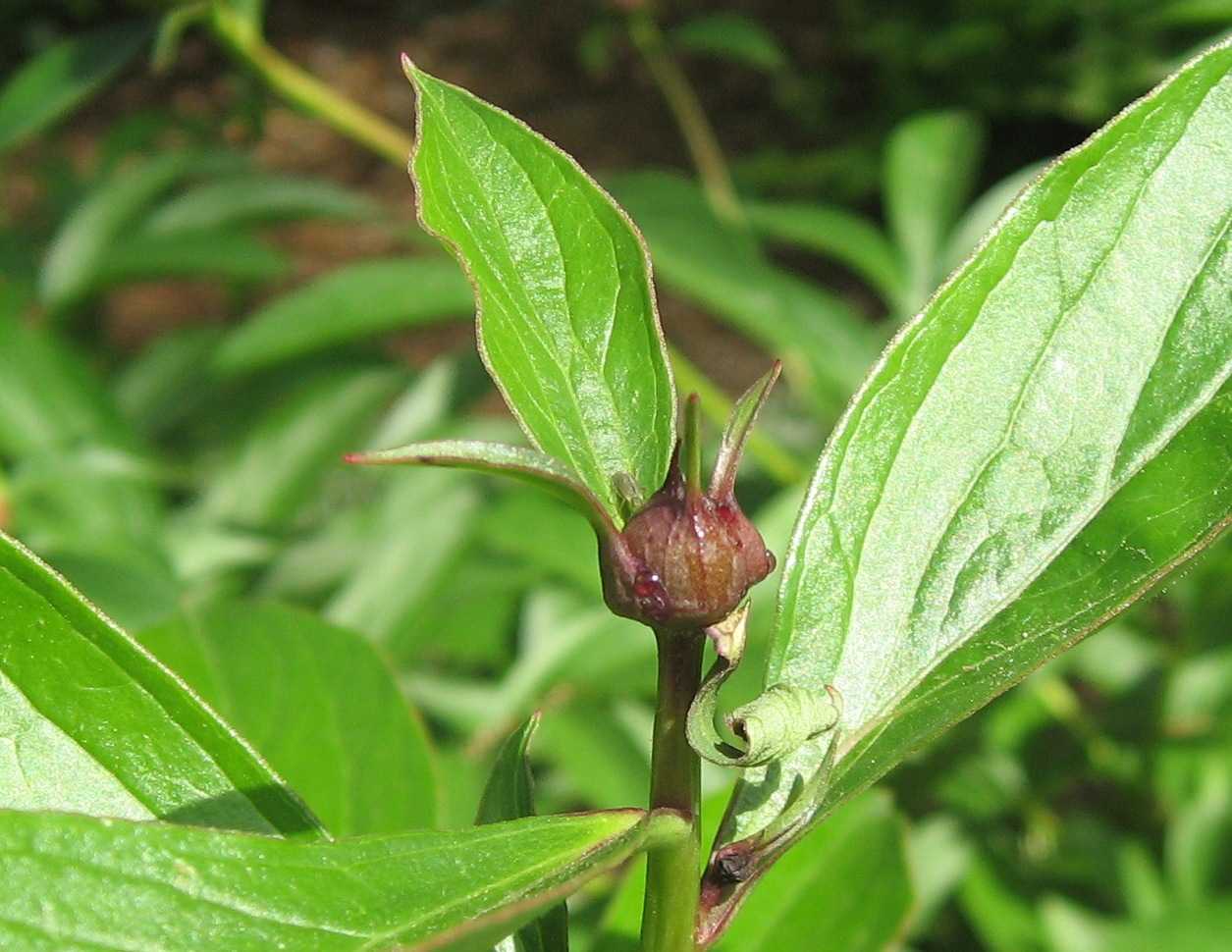
Nectaries on the outside of peony bud oozing nectar and attracting ants
|
Ants
Ants on peony buds are common and totally harmless. They are NOT needed to "open" flower buds as some people maintain. They are attracted to the sugary droplets on the outside of flower buds (nectaries) or to the honeydew produced by scale insects (discussed below).
See "Ants." |
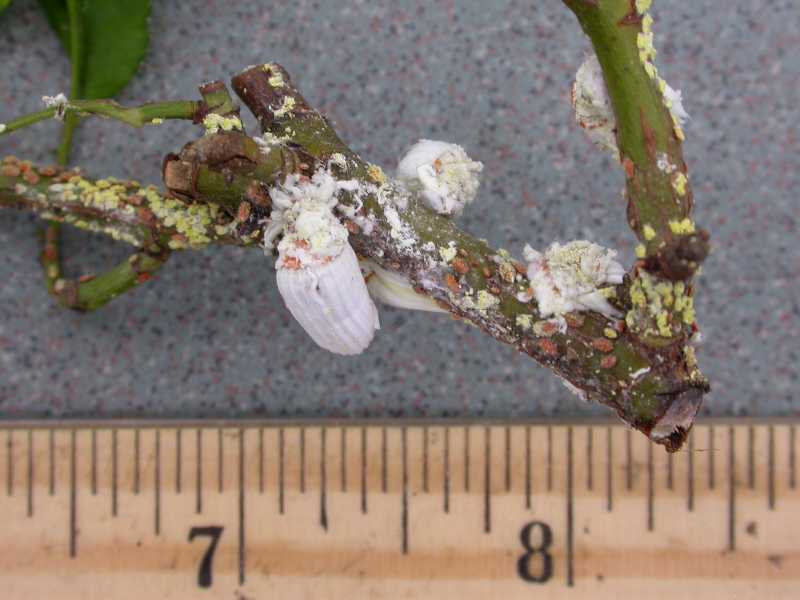
Cottony cushion scale on rose |
Scale insects
Occasionally, peonies may become infested with scale insects. They can be seen on close examination. The most common symptom is that the leaves of the affected plant turn yellow and may drop. Scale insects may also cause reduced growth and stunted plants. In addition, scales carry viruses that can cause plant disease, even when present in small numbers. Some species of scale produce a shiny or sticky material (honeydew) that will cover the leaves of infested plants, thereby attracting ant species that feed this substance to their young.
Lookalikes: Spilled Sprite or 7-Up from last night's party
See “Scale - outdoors.” |
 |
Thrips
Thrips are tiny insects that are difficult to see. They are generally most apparent on flowers, especially light-colored blooms, where they puncture (rasp) petals, causing considerable discoloration and disfiguration. Leaves may become bleached or silver, then wither. Heavy infestations will result in scorched-looking leaves and destroyed blossoms.
Lookalikes: Scorch
See “Thrips - outdoors.” |

Paeonia suffruiticosa |
Tree Peony
Tree peonies are actually shrubby plants. The deeply cut, gray-green foliage is attractive all season. Plant in a protected area. Seek out good quality cultivars for longevity. They are considered to be relatively pest free. As with herbaceous peonies, tree peonies have some susceptibility to canker, leaf blight, stem wilt and scale. Ants on flower buds are common and totally harmless. |
| |
Last updated: 11/2012 View a pdf of this guide |